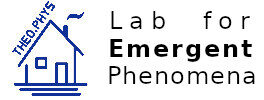PhD thesis – Matthias Saba
Matthias Saba
Photonic crystals with chirality — Group theory, algorithmic tools and experimental approaches for Gyroid-like photonic material
finished 2015-06
supervised by Gerd E. Schröder-Turk
Control over the propagation of light is of prime interest for most biological species since nature started to develop visual receptors about 540 million years ago. During that time evolution has created various different materials to manipulate the flow of light: plants and animals alike use both pigmentation and sub-wavelength structure to generate matte, glare and iridescent colours, often depending on or changing the polarization state of the incident light. This thesis is partly motivated by the demand for an increased understanding of the influence that complex geometrical arrangements of different bio-materials in nature have on their optical behaviour, and partly by the relevance of such geometries for synthetic nanoengineered optical materials and devices.
The focus of this thesis is to understand light-matter interaction for periodically ordered micro-structures, aka photonic crystals, on a fundamental level, with an emphasis on circular polarisation connected to structural chirality. This goal is achieved by calculation, symmetry characterisation and vacuum plane wave surface matching of the solutions of Maxwell’s macroscopic equations for the perfectly periodic, infinite photonic crystal structures under investigation; material properties of single photonic crystal domains are thus enter the continuum model for the charge distribution indirectly via constitutive equations for the polarisation and magnetisation fields.
Practically, the electro-magnetic Bloch eigenmodes and corresponding eigenfre- quencies, constituting a photonic bandstructure, are calculated numerically. While the well-established open-source software MPB is used to calculate purely propa- gating modes, we have developed our own approach based on a plane wave basis and a triangulated interface mesh; this new approach is more general in the sense that it calculates the full set of eigenmodes, including evanescent Bloch modes, and copes with a much broader class of materials, including those with absorption, electro-magnetic cross-coupling and dispersion. The calculated eigenmodes are analysed and enumerated through integral coupling measures and by means of group or, more precisely, representation theory. The new method enables us to match a complete set of eigen-solutions to a Rayleigh basis and thereby allows to predict and understand the scattering behaviour at semi-infinite and finite photonic crystal slabs. The validity of our numerical and analytical predictions is verified via simulation results and through experimental data.
The structures that are investigated are based on triply-periodic saddle surfaces and in particular the so-called Gyroid structure and its srs network graph. Gyroid- like geometries are found in various biological and chemical systems on length scales ranging from roughly 50 nm to 500 nm. The bi-continuous Gyroid structure is of particular interest for photonic applications due to its geometrical properties, that is a high degree of (body-centred cubic) symmetry, simple topology and its chirality that naturally leads to the investigation of circular polarisation properties. Our prediction of a strong circular dichroism signal in the near ultraviolet frequency region generated by the Gyroid realized as a chitin based photonic crystals in the wing-scales of several butterflies, has been confirmed by simulation and experiments on nano-fabricated replicas. It is, however, not present in the reflection spectrum of the biological specimen of the Green Hairstreak C. rubi and the Kaiser-i-hind T. imperialis butterflies, that both build the Gyroid structure.
We have investigated this apparent contradiction, analysing the circular dichroism response of the single Gyroid for different parameters. This study reveals the presence of an unspecified blue-absorbing pigment that, while reducing the overall reflection through absorption, does not decrease the circular dichroism signal. The polycrystalline nature of the butterfly Gyroid structure with different orientations of single crystallites on the other hand strongly reduces the circular polarization signal even if one enantiomeric form is predominant in the butterfly wing scales. Further studies are necessary to reveal the distribution of inclinations and enantiomers.
The bandstructure circular dichroism results relating to the single Gyroid have been confirmed by direct laser writing replicas and converted into a proof-of-concept optical device, a circular polarisation beamsplitter. This device has been fabricated and analysed in collaboration with the Centre for Micro-Photonics at Swinburne University, Melbourne. In the shape of a triangular prism it contains 64 000 unit cells of the Gyroid structure, realised as a tubular network. This microscopic beamsplitter, with spatial dimensions less than 100 μm, discriminates between the two circular polarization states at telecommunication wavelengths around 1.5 μm. A further class of structures are n-srs structures that result from the symmetric intergrowth of multiple copies of the srs-net. This thesis predicts that the 4-srs and 8-srs geometries show remarkable optical effects if realized as a photonic crystal. The features revealed in this thesis include a broadband circular polarization stop-band and strong optical rotation in the absence of ellipticity.
While not yet observed in nature, n-srs materials provide blue-prints for chiral photonic materials. The transmission spectrum along the [100] direction of the body-centred cubic 8-srs photonic crystal shows no circular dichroism, i.e. different reflection and/or transmission for left and right circularly polarized light, despite its strong chirality.
We have developed a theory based on representation theory and scattering matrix calculations that yields analytical results for the scattering parameters, valid for any material with 432 symmetry, and thereby explains this unexpected behaviour. The characterization of bandstructure modes along a 4-fold axis by their symmetry behaviour reveals that all modes fall into four disjoint classes: two dark modes and those which only couple to a left- or right-circularly polarized incident plane wave, respectively. Generally, our symmetry analysis reveals the degeneracy and topology of the bandstructure and therefore classifies photonic crystals by their space group, in contrast to plain bandstructure that provides a classification for the translation group only, providing a valuable tool to pre-select photonic crystals by their symmetry for certain applications.
